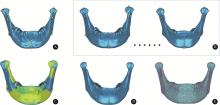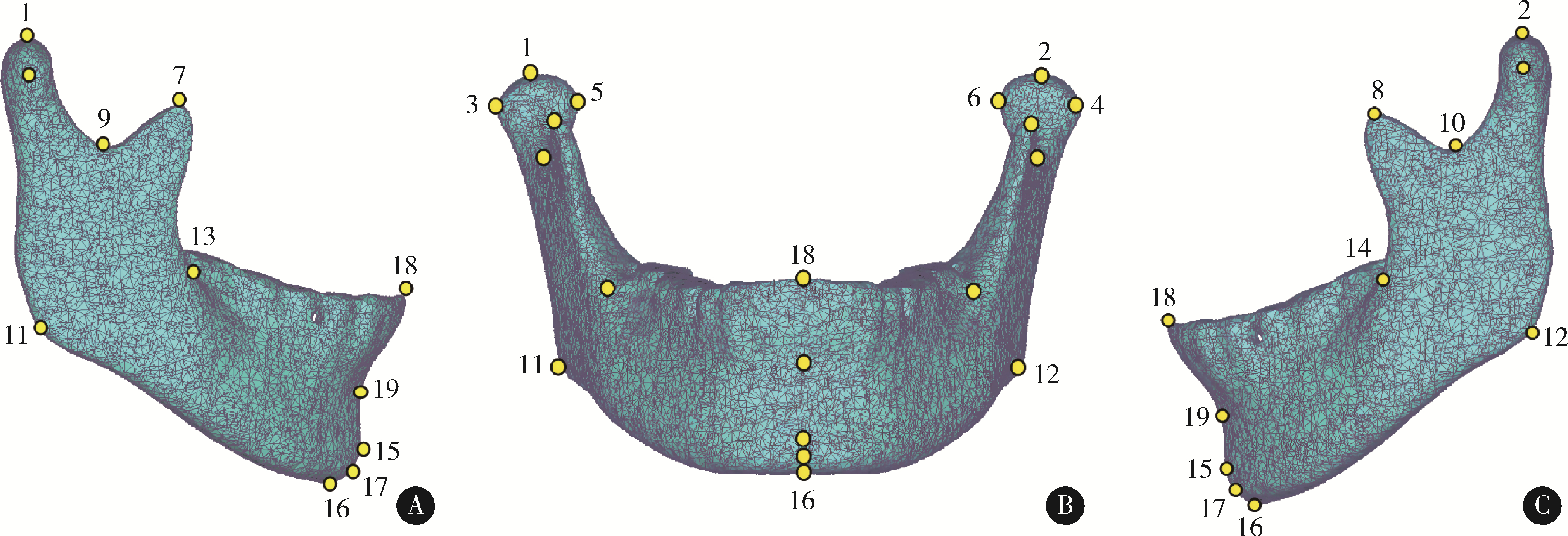Journal of Peking University (Health Sciences) ›› 2023, Vol. 55 ›› Issue (1): 174-180. doi: 10.19723/j.issn.1671-167X.2023.01.027
Previous Articles Next Articles
Automatic determination of mandibular landmarks based on three-dimensional mandibular average model
Zi-xiang GAO1,Yong WANG1,2,Ao-nan WEN2,Yu-jia ZHU2,Qing-zhao QIN2,Yun ZHANG3,Jing WANG4,*( ),Yi-jiao ZHAO1,*(
),Yi-jiao ZHAO1,*( )
)
- 1. Institute of Medical Technology, Peking University Health Science Center, Beijing 100191, China
2. Center of Digital Dentistry, Peking University School and Hospital of Stomatology & National Center of Stomatology & National Clinical Research Center for Oral Diseases & National Engineering Research Center of Oral Biomaterials and Digital Medical Devices & Beijing Key Laboratory of Digital Stomatology & NHC Research Center of Engineering and Technology for Computerized Dentistry, Beijing 100081, China
3. Lanzhou Stomatological Hospital, Lanzhou 730031, China
4. Department of Oral and Maxillofacial Surgery, Peking University School and Hospital of Stomatology, Beijing 100081, China
CLC Number:
- R782.2
| 1 |
Kakarala K , Shnayder Y , Tsue TT , et al. Mandibular reconstruction[J]. Oral Oncol, 2018, 77, 111- 117.
doi: 10.1016/j.oraloncology.2017.12.020 |
| 2 | 中华口腔医学会口腔颌面修复专业委员会. 下颌骨缺损修复重建治疗专家共识[J]. 中华口腔医学杂志, 2019, 54 (7): 433- 439. |
| 3 |
Bak M , Jacobson AS , Buchbinder D , et al. Contemporary reconstruction of the mandible[J]. Oral Oncol, 2010, 46 (2): 71- 76.
doi: 10.1016/j.oraloncology.2009.11.006 |
| 4 |
张鑫, 刘洋, 周建萍, 等. 点构法构建下颌骨正中矢状平面的初步探究[J]. 上海交通大学学报(医学版), 2019, 39 (1): 52- 59.
doi: 10.3969/j.issn.1674-8115.2019.01.010 |
| 5 |
周子疌, 朱向阳, 韩婧, 等. 基于机器学习的颌骨特征点还原法辅助跨中线颌骨缺损重建[J]. 中国口腔颌面外科杂志, 2020, 18 (4): 323- 327.
doi: 10.19438/j.cjoms.2020.04.007 |
| 6 | Wang E , Tran KL , D'Heygere E , et al. Predicting the premorbid shape of a diseased mandible[J]. Laryngoscope, 2021, 131 (3): E781- E786. |
| 7 | 史雨林. 骨性Ⅲ类患者正颌手术前后面部软硬组织变化的3D研究[D]. 西安: 中国人民解放军空军军医大学, 2018. |
| 8 |
潘思思, 王昕, 戴微微, 等. 替牙期儿童下颌骨发育的三维特征[J]. 温州医科大学学报, 2014, 44 (10): 712- 717.
doi: 10.3969/j.issn.2095-9400.2014.10.004 |
| 9 |
Neelapu BC , Kharbanda OP , Sardana V , et al. Automatic localization of three-dimensional cephalometric landmarks on CBCT images by extracting symmetry features of the skull[J]. Dentomaxillofac Radiol, 2018, 47 (2): 20170054.
doi: 10.1259/dmfr.20170054 |
| 10 | Zhang J , Liu M , Wang L , et al. Joint craniomaxillofacial bone segmentation and landmark digitization by context-guided fully convolutional networks[J]. Med Image Comput Comput Assist Interv, 2017, 10434, 720- 728. |
| 11 |
Zhang J , Liu M , Wang L , et al. Context-guided fully convolu-tional networks for joint craniomaxillofacial bone segmentation and landmark digitization[J]. Med Image Anal, 2020, 60, 101621.
doi: 10.1016/j.media.2019.101621 |
| 12 | Zheng YF, Liu D, Georgescu B, et al. 3D deep learning for efficient and robust landmark detection in volumetric data: 18th International Conference on Medical Image Computing and Computer-Assisted Intervention (MICCAI)[C]. Munich, Germany: Springer, 2015: 565-572. |
| 13 |
White JD , Ortega-Castrillón A , Matthews H , et al. MeshMonk: Open-source large-scale intensive 3D phenotyping[J]. Sci Rep, 2019, 9 (1): 6085.
doi: 10.1038/s41598-019-42533-y |
| 14 | 任敏. 基于MSCT汉族成年人群活体下颌骨三维测量数据库的建立及三维测量研究[D]. 北京: 北京协和医学院, 2008. |
| 15 | Goodall C . Procrustes methods in the statistical analysis of shape[J]. J R Stat Soc B, 1991, 53 (2): 285- 321. |
| 16 |
温奥楠, 朱玉佳, 郑盛文, 等. 基于三维人脸模板的颜面解剖标志点自动定点方法初探[J]. 中华口腔医学杂志, 2022, 57 (4): 358- 365.
doi: 10.3760/cma.j.cn112144-20210913-00409 |
| 17 |
Ghoddousi H , Edler R , Haers P , et al. Comparison of three methods of facial measurement[J]. Int J Oral Maxillofac Surg, 2007, 36 (3): 250- 258.
doi: 10.1016/j.ijom.2006.10.001 |
| 18 |
Douglas TS . Image processing for craniofacial landmark identification and measurement: A review of photogrammetry and cephalo-metry[J]. Comput Med Imaging Graph, 2004, 28 (7): 401- 409.
doi: 10.1016/j.compmedimag.2004.06.002 |
| 19 | Abu A , Ngo CG , Abu-Hassan NIA , et al. Automated craniofacial landmarks detection on 3D image using geometry characteristics information[J]. BMC Bioinformatics, 2019, 19 (Suppl 13): 548. |
| 20 | Liang S, Wu J, Weinberg SM, et al. Improved detection of landmarks on 3D human face data: 35th Annual International Conference of the IEEE-Engineering-in-Medicine-and-Biology-Society (EMBC)[C] Osaka, Japan: Institule of Electrical and Electronics Engineers, 2013: 6482-6485. |
| 21 |
Wang K , Zhao X , Gao W , et al. A coarse-to-fine approach for 3D facial landmarking by using deep feature fusion[J]. Symmetry, 2018, 10 (8): 308.
doi: 10.3390/sym10080308 |
| 22 | Paulsen RR, Juhl KA, Haspang TM, et al. Multi-view consensus CNN for 3D facial landmark placement: 14th Asian Conference on Computer Vision (ACCV)[C]. Australia: Springer, 2019: 706-719. |
| 23 | 李婧宇. 北方汉族女性三维平均脸的构建并用于面部形态随年龄变化研究[D]. 北京: 北京协和医学院, 2017. |
| 24 |
Kuijpers M , Maal T , Meulstee JW , et al. Nasolabial shape and aesthetics in unilateral cleft lip and palate: An analysis of nasolabial shape using a mean 3D facial template[J]. Int J Oral Maxillofac Surg, 2021, 50 (2): 267- 272.
doi: 10.1016/j.ijom.2020.06.003 |
| 25 |
Damstra J , Fourie Z , De Wit M , et al. A three-dimensional comparison of a morphometric and conventional cephalometric midsagittal planes for craniofacial asymmetry[J]. Clin Oral Investig, 2012, 16 (1): 285- 294.
doi: 10.1007/s00784-011-0512-4 |
| 26 |
Fagertun J , Harder S , Rosengren A , et al. 3D facial landmarks: Inter-operator variability of manual annotation[J]. BMC Med Imaging, 2014, 14, 35.
doi: 10.1186/1471-2342-14-35 |
| [1] | Wen ZHANG,Xiao-jing LIU,Zi-li LI,Yi ZHANG. Effect of alar base cinch suture based on anatomic landmarks on the morphology of nasolabial region in patients after orthognathic surgery [J]. Journal of Peking University (Health Sciences), 2023, 55(4): 736-742. |
| [2] | Han LU,Jian-yun ZHANG,Rong YANG,Le XU,Qing-xiang LI,Yu-xing GUO,Chuan-bin GUO. Clinical factors affecting the prognosis of lower gingival squamous cell carcinoma [J]. Journal of Peking University (Health Sciences), 2023, 55(4): 702-707. |
| [3] | Wei ZHOU,Jin-gang AN,Qi-guo RONG,Yi ZHANG. Three-dimensional finite element analysis of traumatic mechanism of mandibular symphyseal fracture combined with bilateral intracapsular condylar fractures [J]. Journal of Peking University (Health Sciences), 2021, 53(5): 983-989. |
| [4] | DAI Fan-fan, LIU Yi, XU Tian-min, CHEN Gui. Exploring a new method for superimposition of pre-treatment and post-treatment mandibular digital dental casts in adults [J]. Journal of Peking University(Health Sciences), 2018, 50(2): 271-278. |
| [5] | LI Shi-ying, LI Gang, FENG Hai-lan, PAN Shao-xia. Influence of the interforaminal arch form of edentulous mandibles on design of “All-on-4”: preliminary research based on conebeam computed tomography [J]. Journal of Peking University(Health Sciences), 2017, 49(4): 699-703. |
| [6] | CHEN Quan, GUO Chuan-Bin, GAO Tao. Three dimensional CT for measuring mandibles morphology in 54 normal Chinese adults [J]. Journal of Peking University(Health Sciences), 2015, 47(1): 113-119. |
| [7] | JIANG Xi, LIN Ye, HU Xiu-Lian, DI Ping, LUO Jia, LI Jian-Hui. Computer-assisted implant restoration of free-end partially edentulous mandible with severe vertical bone deficiency [J]. Journal of Peking University(Health Sciences), 2014, 46(2): 294-298. |
| [8] | ZHAO Ying, DONG Ying-tao, WANG Xiao-yan, WANG Zu-hua, LI Gang, LIU Mu-qing, FU Kai-yuan. Cone-beam computed tomography analysis of root canal configuration of 4 674 mandibular anterior teeth [J]. Journal of Peking University(Health Sciences), 2014, 46(1): 95-99. |
| [9] | ZHANG Lei, LI Yun-xia, KANG Yan-feng, YANG Guang-ju, XIE Qiu-fei. Comparison of self-controlled retruded approach and bimanual manipulation method on the relationship of incisal point displacement in the mandibular retruded contact position [J]. Journal of Peking University(Health Sciences), 2014, 46(1): 67-70. |
|
||





